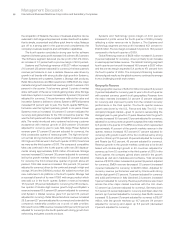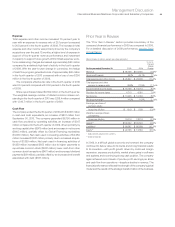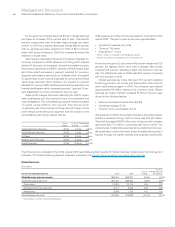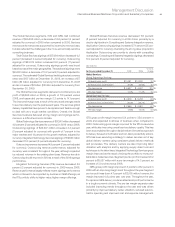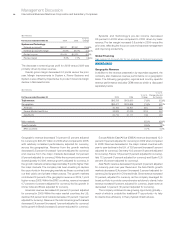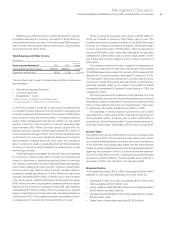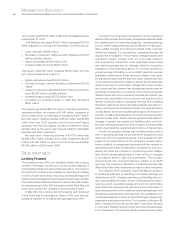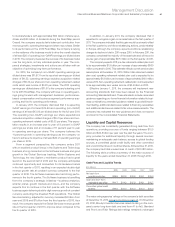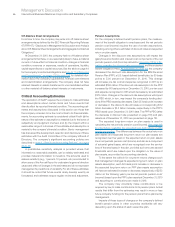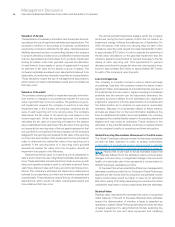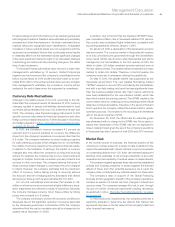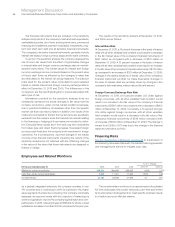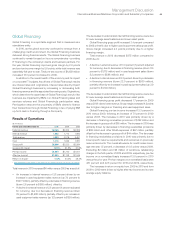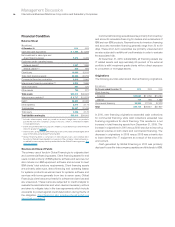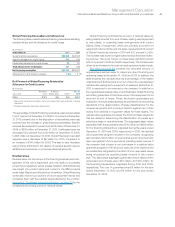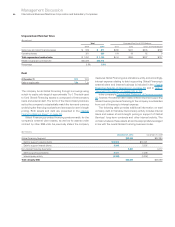IBM 2010 Annual Report Download - page 50
Download and view the complete annual report
Please find page 50 of the 2010 IBM annual report below. You can navigate through the pages in the report by either clicking on the pages listed below, or by using the keyword search tool below to find specific information within the annual report.
48
Management Discussion
International Business Machines Corporation and Subsidiary Companies
from December 31, 2009. The company’s debt securities do not
contain any acceleration clauses which could change the sched-
uled maturities of the obligation. In addition, the company does
not have “ratings trigger” provisions in its debt covenants or
documentation, which would allow the holders to declare an event
of default and seek to accelerate payments thereunder in the event
of a change in credit rating. The company’s contractual agree-
ments governing derivative instruments contain standard market
clauses which can trigger the termination of the agreement if the
company’s credit rating were to fall below investment grade.
At December 31, 2010, the fair value of those instruments that
were in a liability position was $1,006 million, before any applicable
netting, and this position is subject to fluctuations in fair value
period to period based on the level of the company’s outstanding
instruments and market conditions. The company has no other
contractual arrangements that, in the event of a change in credit
rating, would result in a material adverse effect on its financial
position or liquidity.
Moody’s
Standard Investors Fitch
& Poor’s Service Ratings
Senior long-term debt A+ Aa3 A+
Commercial paper A-1 Prime-1 F1
The company prepares its Consolidated Statement of Cash Flows
in accordance with applicable accounting standards for cash flow
presentation on page 64 and highlights causes and events under-
lying sources and uses of cash in that format on page 35. For
purposes of running its business, the company manages, monitors
and analyzes cash flows in a different format.
Management uses a free cash flow measure to evaluate the
company’s operating results, plan share repurchase levels, eval-
uate strategic investments and assess the company’s ability and
need to incur and service debt. Free cash flow is not a defined
term under GAAP and it should not be inferred that the entire free
cash flow amount is available for discretionary expenditures. The
company defines free cash flow as net cash from operating
activities less the change in Global Financing receivables and net
capital expenditures, including the investment in software. As
discussed on page 23, a key objective of the Global Financing
business is to generate strong returns on equity. Increasing receiv-
ables is the basis for growth in a financing business. Accordingly,
management considers Global Financing receivables as a profit-
generating investment, not as working capital that should be
minimized for efficiency. After considering Global Financing receiv-
ables as an investment, the remaining net operational cash flow
less net capital expenditures is viewed by the company as free
cash flow.
From the perspective of how management views cash flow, in
2010, free cash flow was $16.3 billion, an increase of $1.2 billion
compared to 2009. This cash performance was driven primarily by
the growth in net income of $1.4 billion and increased cash provided
by other assets/liabilities of $1.1 billion. These increases were
partially offset by higher income tax payments of approximately
$1.0 billion and a decrease in cash of approximately $0.6 billion,
as a result of lower tax refunds in 2010 versus the prior year.
Over the past five years, the company generated over $68
billion in free cash flow. During that period, the company invested
$18 billion in strategic acquisitions and returned over $72 billion to
shareholders through dividends and share repurchases. The
amount of prospective returns to shareholders in the form of
dividends and share repurchases will vary based upon several
factors including each year’s operating results, capital expenditure
requirements, research and development investments and acqui-
sitions, as well as the factors discussed on page 49.
The company’s Board of Directors meets quarterly to consider
the dividend payment. In the second quarter of 2010, the Board
of Directors increased the company’s quarterly common stock
dividend from $0.55 to $0.65 per share.
The table below represents the way in which management reviews cash flow as described above.
($ in billions)
For the year ended December 31: 2010 2009 2008 2007 2006
Net cash from operating activities per GAAP (Continuing Operations) $ 19.5 $20.8 $ 18.8 $ 16.1 $15.0
Less: the change in Global Financing receivables (0.7) 1.9 (0.0) (1.3) (0.3)
Net cash from operating activities (Continuing Operations),
excluding Global Financing receivables 20.3 18.9 18.8 17.4 15.3
Capital expenditures, net (4.0) (3.7) (4.5) (5.0) (4.7)
Free cash flow (excluding Global Financing receivables) 16.3 15.1 14.3 12.4 10.5
Acquisitions (5.9) (1.2) (6.3) (1.0) (3.8)
Divestitures 0.1 0.4 0.1 0.3 —
Share repurchase (15.4) (7.4) (10.6) (18.8) (8.1)
Dividends (3.2) (2.9) (2.6) (2.1) (1.7)
Non-Global Financing debt 2.3 (4.7) (3.2) 10.9 (1.1)
Other (includes Global Financing receivables and Global Financing debt) 3.5 1.7 5.0 3.8 1.1
Change in cash, cash equivalents and short-term marketable securities $ (2.3) $ 1.1 $ (3.2) $ 5.5 $ (3.0)


